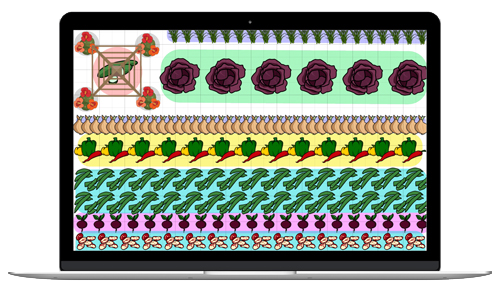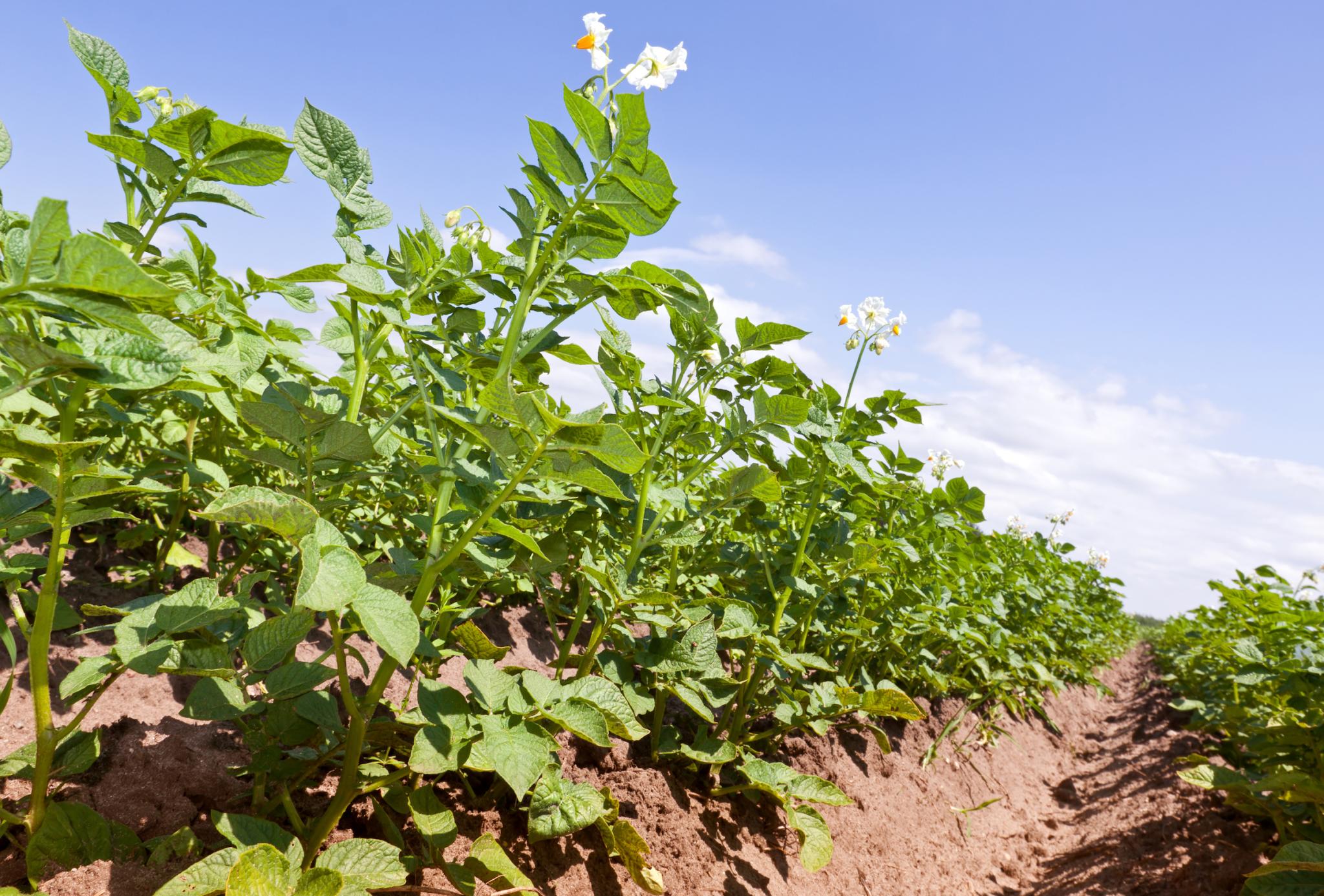
Planting, Growing, Harvesting, and Storing Potato Plants
The Almanac Garden Planner - Use It Free for 7 Days!
Plan your 2025 garden with our award-winning Garden Planner.
There are three classifications for potatoes based on when you harvest (vs. when you plant). If you harvest for storage, be sure to choose the right type:
- Early-season potatoes: first to be planted in early spring. Grow quickly (60 to 80 days), ready to harvest by early summer, tender flesh, thinner skin, store up to a few weeks.
- Mid-season potatoes (aka second early potatoes or “earlies”): mature in 80 to 100 days, typically lifted up from second half of summer, store up to a month.
- Late crops: mature in 100 to 130 days, best for storing, lasting 2 to 3 months in the right conditions; planted in August and harvested in fall.
Also, decide on the texture and flavor of your potatoes, and how you’d like to eat them:
- Dry-fleshed, mealy potatoes like russets and long white potatoes are used for baking, frying, and mashing. As mashed potatoes, they will not be gluey, and they will absorb gravy, butter or sour cream.
- Moist, waxy, round potatoes are great in soups, curries, frittatas, and salads because they don’t fall apart when cooked. You can pan-fry leftover boiled potatoes. When you mash waxy potatoes, they can become sticky.
- Red-skinned potatoes are often used for boiling or for potato salads.
Some popular potato varieties, such as ‘Yukon Gold’, fall somewhere in between truly waxy and mealy.
There are over 100 potato plant varieties! Go beyond the Idaho potato to explore more exotic and delicious options. See our article on choosing the best potato varieties!
Early Varieties:
- ‘Irish Cobbler’: tan skin, irregular shape (great heirloom potato for delicious mashed potatoes!)
- ‘Red Norland’: deep red skin, sweet, delicate flavor, great in potato salads or boiled
- ‘Mountain Rose’: red skin and pink flesh, resistant to some viruses
Mid-Season Varieties
- ‘Yukon Gold’: popular, tan skin and buttery-yellow flesh, mid to large size
- ‘Red Pontiac’: red skin, deep eyes (easiest and most adaptable red potato there is to grow)
- ‘Viking’: red skin, very productive
- ‘Chieftan’: red skin, resistant to potato scab, stores well
Late Varieties
- ‘Katahdin’: tan skin, resistant to some viruses
- ‘Kennebec’: tan skin, resistant to some viruses and late blight
- ‘Elba’: tan skin, large round tubers, resistant to blight and potato scab
- All Blue Potatoes
- ‘Fingerling Salad’ potatoes
Cooking Notes
Potatoes can be prepared in many ways: boiled, mashed, cut into pieces and roasted, french-fried, scalloped, made into dumplings or pancakes, grated into hash browns, and even brewed as alcoholic beverages.
Most potato dishes are served hot, but some are first cooked, then served cold, notably potato salad and potato chips.
ADVERTISEMENT
If you’ve had potato scab before, check the pH of your soil and adjust it to 5.2 or a bit lower, down to about 4.8. To do this, you can add sulfur. You can also dip the cut seed potatoes in sulfur before planting, to help deter disease, including scab. As for using a soil acidifier for blueberries — that plant likes the pH in about the same range. If your product is basically elemental sulfur, without other additives focused on blueberry growth, then it should be fine to use.
Last fall I apparently missed some russets when digging up my crop and they replanted themselves. This spring I did use left over tubers from last year to plant my new crop (which I know is not advised). When I recently dug up this year's crop, to my surprise, the plants that grew from the potatoes I missed last year were much more productive than the ones I purposely planted. Why would this be? Is it that they simply got a head start?
The usual approach to ‘volunteers’ is to dig them up because they get blight and the last thing you want is disease. But it’s up to you. If the potatoes seem good, just look at them closely and make a call. Most volunteers are poor. It’s all experimentation!
to allow you paid volunteers to flourish within you properly you have to provide them witha moist base lubrication
Hello I have been growing potatoes and I have noticed some small round green things that look like tomatoes just a bit harder I was wondering if you can tell me what they are please ?
Hi, I would like to know if after you graft a potato and tomato together using well drained moist media, hydroponically with drip feeding, would the potato or sweet potato rot or become larger and better yields being left in the media until the tomato plant was pulled out after it's 3rd-4th harvest?
Hi, Thomas, The small round green things on the potato plants … are potato fruit. Potatoes and tomatoes are in the same family (Nightshade) and are the most alike two plants in this family. Potato fruit and flowers are produced because this is how the plants multiply themselves—by seed. Both potatoes and tomatoes produce flowers; those on potatoes usually fall off and never develop into anything. However, … this year’s weather in some parts of the country—cool temps and rain—is “causing” (enabling?) them to remain on the plant, pollinate, and produce small fruit that resemble small tomatoes.
These are not edible; they are bitter-tasting and contain high amounts of solanine that can make you —or worse.
Trying to grow potatoes from the seeds could take years. Only breeders and growers find them useful.
So enjoy them. You may not see them again for a while. And your potatoes under the soil will be fine.
Thanks for asking!
I want to be right guided about different farming
I had 5 huge healthy potato plants and now none... :( all it has done is rain rain rain rain... I had two stragglers hanging on and they were about to spring back but guess what it rained again and today I looked and it looked like they were dying once again.. well you know what it's stinking 1 am and you know what it's doing again? RAINING!! I thought potatoes needed a lot if water/moisture? My potato box has plenty of holes in it for run off... I a so frustrated this was my first time for potatoes and they were so tall too they were about 4 foot high. Did the water really kill them?
How frustrating! Potatoes do like even moisture, about 1 to 2 inches of water a week. It sounds, though, as if yours got a lot more because of the uncooperative weather. You might still check below in the soil to see if any of the potato tubers survived and are still edible. Too much moisture can cause tubers to grow abnormally, such as cracks or odd nobs. The most important concern, perhaps, is that a lot of rain or overwatering, on leaves or in soil, can lead to disease, such as various wilts and rots. If you’d like to try again next year, and if you expect a lot of rain, perhaps you could devise a rain barrier (a large umbrella, even, might help to protect a single plant in a pot), or move containers under a shelter, if possible, during those downpours.














